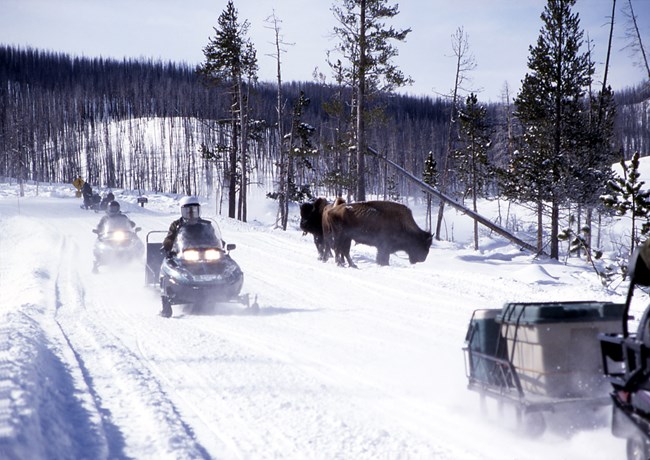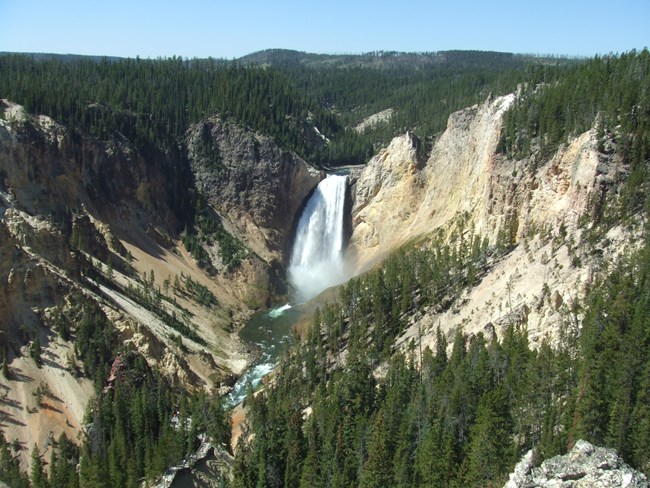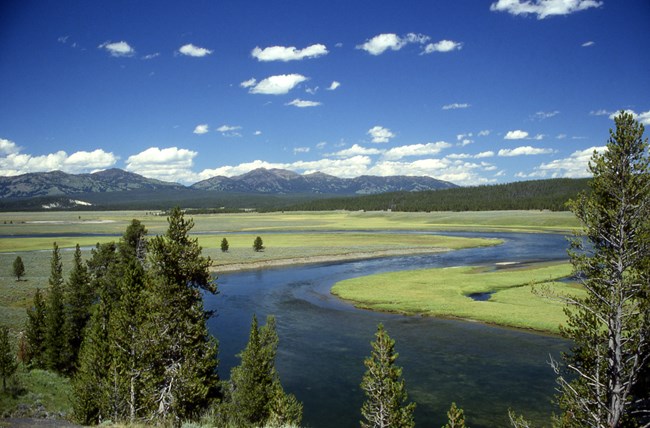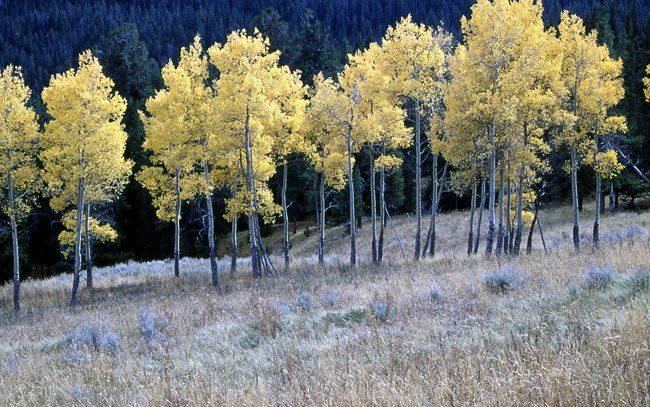Part of a series of articles titled Park Air Profiles.
Article
Park Air Profiles - Yellowstone National Park
Air Quality at Yellowstone National Park
Most visitors expect clean air and clear views in parks. Yellowstone National Park (NP), America’s first national park and home to the Old Faithful geyser, is located in Wyoming, Montana, and Idaho. The park is downwind of significant pollutant sources, including power plants, agricultural areas, industry, and oil and gas development. Even emissions from over-snow vehicles affect winter air quality. Air pollution can harm the park’s natural and scenic resources such as surface waters, vegetation, and visibility. The National Park Service works to address air pollution effects at Yellowstone NP, and in parks across the U.S., through science, policy and planning, and by doing our part.
Highlight: Winter Air Quality

Since the mid 1970’s, snowmachine use been an increasingly popular winter tourist activity at Yellowstone NP (Yochim 1999). Although park visitation is far lower in the winter than in the summer, over-snow vehicles produce more emissions than cars (NPS 2000). Air pollution from over-snow vehicles has historically been problematic at congested locations such as park entrance stations, rest areas, thermal feature parking lots, and at Old Faithful.
In the 1990’s and early 2000’s, elevated levels of carbon monoxide (CO), fine particulate matter (< 2.5 micrometers), and hydrocarbons reached harmful levels in high traffic areas, creating a health risk for visitors and park employees. In addition, concentrations of ammonium, nitrate, sulfate, and other contaminants in snow along park roads were positively correlated with snowmobile use (Ingersoll 1999). Over-snow vehicle management changes have been effective in reducing air pollutant levels in the park. Such changes include: lowering numbers of vehicles allowed, requiring use of best available technology to reduce emissions, and modifying entrance station procedures to reduce over-snow vehicle numbers concentrated in one spot (YELL 2011).
Learn more about winter use at Yellowstone NP.
Nitrogen and Sulfur

Nitrogen (N) and sulfur (S) compounds deposited from the air may have harmful effects on ecosystem processes. Healthy ecosystems can naturally buffer a certain amount of pollution, but once a threshold is passed the ecosystem may respond negatively. This threshold is the critical load, or the amount of pollution above which harmful changes in sensitive ecosystems occur (Porter 2005). N and S deposition change ecosystems through eutrophication (N deposition) and acidification (N + S deposition). Eutrophication increases soil and water nutrients which causes some species to grow more quickly and changes community composition. Ecosystem sensitivity to nutrient N enrichment at Yellowstone National Park (YELL) relative to other national parks is very high (Sullivan et al. 2016); for a full list of N sensitive ecosystem components, see: NPS ARD 2019. Acidification leaches important cations from soils, lakes, ponds, and streams which decreases habitat quality. Ecosystem sensitivity to acidification at YELL relative to other national parks is very high (Sullivan et al. 2016); to search for acid-sensitive plant species, see: NPSpecies.
From 2017-2019 total N deposition in YELL ranged from 2.6 to 7.1 kg-N ha-1 yr-1 and total S deposition ranged from 0.9 to 2.0 kg-S ha-1 yr-1 based on the TDep model (NADP, 2018). YELL has been monitoring atmospheric N and S deposition since 1980, see the conditions and trends website for park-specific information.
N-Sensitive plant communities in YELL include alpine, arid and semi-arid, grassland and meadow, and wetland (Sullivan et al. 2016). Lakes at elevations above 2,600 meters in YELL have the greatest sensitivity to acidification. Arid shrublands dominated by sagebrush are widespread and have shown variable responses to changes caused by N deposition. Studies in other sagebrush steppe areas suggest that increased N can deplete soil moisture and affect water uptake and use by plants.
Alpine ecosystem effects
Alpine environments are particularly vulnerable to large inputs of reactive nitrogen because of the sparse cover of vegetation, short growing seasons, large areas of exposed bedrock and talus, and snowmelt nutrient releases (Williams et al., 1996; Nanus et al., 2012). Approximately 16% of the land area in YELL is alpine (~328 km2 above 1550 m). McClung et al. (2021) compared the 2015 estimated total N deposition (TDep; NADP, 2018) to the critical load of N for an increase in alpine sedge growth (alpine plant critical load = 3 kg-N ha-1yr-1) and the critical load of N for alpine soil nitrate leaching (alpine soil critical load = 10 kg-N ha-1yr-1; Bowman et al., 2012). They found that deposition exceeded the alpine plant critical load in 89% of the park’s alpine area, but was below the alpine soil critical load throughout the parks’s entire alpine area.
Epiphytic macrolichen community responses
Epiphytic macrolichens grow on tree trunks, branches, and boles. Since these lichens grow above the ground, they obtain all their nutrients directly from precipitation and the air. Many epiphytic lichen species have narrow environmental niches and are extremely sensitive to changes in air pollution. Epiphytic lichen communities are less diverse in arid areas, but are still impacted by air pollution. Geiser et al. (2019) used a U.S. Forest Service national survey to develop critical loads of nitrogen (N) and critical loads of sulfur (S) to prevent more than a 20% decline in four lichen community metrics: total species richness, pollution sensitive species richness, forage lichen abundance, and cyanolichen abundance.
McCoy et al. (2021) used forested area from the National Land Cover Database to estimate the impact of air pollution on epiphytic lichen communities. Forested area makes up 3481 km2 (39.1%) of the land area of Yellowstone National Park.
- N deposition exceeded the 3.1 kg-N ha-1 yr-1 critical load to protect N-sensitive lichen species richness in 73.0% of the forested area.
- S deposition was below the 2.7 kg-S ha-1 yr-1 critical load to protect S-sensitive lichen species richness in every part of the forested area.
For exceedances of other lichen metrics and the predicted decline of lichen communities see Appendices A and B of McCoy et al. (2021).
Additional modeling was done on 459 lichen species to test the combined effects of air pollution and climate gradients (Geiser et al. 2021). A critical load indicative of initial shifts from pollution-sensitive toward pollution-tolerant species occurred at 1.5 kg-N ha-1 yr-1 and 2.7 kg-S ha-1 yr-1 even under changing climate regimes.
Plant species response
Plants vary in their tolerance of eutrophication and acidification, and some plant species respond to nitrogen (N) or sulfur (S) pollution with declines in growth, survival, or abundance on the landscape. Horn et al. (2018) used the U.S. Forest Service national forest survey to develop critical loads of N and critical loads of S to prevent declines in growth or survival of sensitive tree species. Clark et al. (2019) used a database of plant community surveys to develop critical loads of N and critical loads of S to prevent a decline in abundance of sensitive herbaceous plant species. According to NPSpecies, Yellowstone National Park contains:
- 4 N-sensitive tree species and 34 N-sensitive herbaceous species.
- 7 S-sensitive tree species and 31 S-sensitive herbaceous species.
Mycorrhizal fungi community response
Many plants have a symbiotic relationship with mycorrhizal fungi (MF). Through the roots, the plants supply the fungi with carbon from photosynthesis and in exchange the MF enhance nutrient availability within soils, increase drought tolerance, and provide physical resistance to soil erosion (George et al., 1995; Cheng et al., 2021; Burri et al., 2013). Anthropogenic Nitrogen (N) deposition can disrupt this symbiotic relationship resulting in a shift from N sensitive to N tolerant mycorrhizal fungi and plant communities.
With increased N deposition to the soil, MF become less important for nutrient uptake and many plants will cease the exchange of nutrients altogether making them more vulnerable to stressors such as drought (Lilleskov et al., 2019). The CL-N for the shift in mycorrhizal community is 5-6 kg-N ha-1 yr-1 in coniferous forests and 10-20 kg-N ha-1 yr-1 broadleaf forests.
Yellowstone National Park has 4880.4 km2 of coniferous forests, 1.4 km2 of broadleaf forests, and 1.1 km2 of mixed forests. Using the range in critical loads above, the minimum CL is exceeded in 13.7% of forested area and the maximum CL is exceeded in 4.5% of forested area based on 2019-2021 TDep Total N deposition.
Change in N and S deposition from 2000 to 2021
The maps below show how the spatial distribution of estimated Total N and Total S deposition in YELL has changed from 2000-2002 to 2019-2021 (TDep MMF version 2022.02). Slide the arrows in the middle of the image up and down to compare N and S deposition between the two years (Yearly Data).
- Minimum N deposition increased from 1.9 to 2.7 kg-N ha-1 yr-1 and maximum N deposition increased from 6.3 to 7.5 kg-N ha-1 yr-1.
- Minimum S deposition decreased from 0.6 to 0.5 kg-S ha-1 yr-1 and maximum S deposition decreased from 2.1 to 1.7 kg-S ha-1 yr-1.


Persistent Pollutants
Pollutants like mercury and pesticides are concerning because they are persistent and toxic in the environment. These contaminants can travel in the air thousands of miles away from the source of pollution, even depositing in protected places like national parks. In addition, while some of these harmful pollutants may be banned from use, historically contaminated sites continue to endure negative environmental consequences.
When deposited, airborne mercury and other toxic air contaminants are known to harm wildlife like birds and fish, and cause human health concerns. Many of these substances enter the food chain and accumulate in the tissue of organisms causing reduced reproductive success, impaired growth and development, and decreased survival.
- Mercury concentrations in some fish sampled at Yellowstone exceeded the toxicity thresholds for birds and human consumption. Fish were analyzed for mercury from 4 sites at the park and compared to data across 21 western parks. The average fish mercury concentration (101.2 ng/g ww) was higher than the study-wide mean (77.7 ng/g ww). Mercury concentrations exceeded the threshold for bird toxicity and US EPA’s human consumption guidance in 20% and 1% of fish sampled, respectively (Eagles-Smith et al. 2014). Fish consumption advisories may be in effect for mercury and other contaminants (NPS 2022).
- Some dragonfly larvae sampled at Yellowstone had mercury concentrations at moderate or higher impairment levels. Dragonfly larvae have been sampled and analyzed for mercury from 27 sites in the park; 28% of the data fall into the moderate (100-300 ng/g dw) and 41% fall into the high/severe (>300 ng/g dw) impairment categories for potential mercury risk. An index of moderate impairment or higher suggests some fish may exceed the US EPA benchmark for protection of human health (Eagles-Smith et al. 2020; Eagles-Smith et al. 2018). However, the data may not reflect the risk at other unsampled locations in the park.
- Microplastics were found in park water, fish, and insects. Materials including microplastics and glass fibers were found in 22% of samples from the park (Driscoll et al. 2021).
- Related studies also found mercury in air, snowpack, and lake water samples from Yellowstone. The average mercury concentration found in snowpack in 2021 was 1.74 ng/L at Canyon, 1.16 ng/L at Lewis Lake Divide, and 2.6 ng/L at Sylvan Lake (Ingersoll et al. 2007; USGS 2021). Elevated levels of mercury were found in some park air samples (Hall et al. 2006). Methylmercury was found in lake water samples, although high-altitude lakes had generally low methylmercury concentrations (Krabbenhoft et al. 2002).
- Over-snow vehicles emit toxic air pollutants. Compounds including benzene, toluene, and polycyclic aromatic hydrocarbons (PAHs) have been measured at levels of concern to human health (Bishop et al. 2001; NPS 2000).
- Mercury sources at Yellowstone are unique in that not only are there contributions from regional coal-burning power plants and wildfires, but also from the many natural geothermal features scattered throughout the park (Hall et al. 2006; Peterson et al. 1998).
The NPS Air Resources Division reports on park conditions and trends for mercury. Visit the webpage to learn more.
Visibility

Visitors come to Yellowstone NP to enjoy views of spectacular geysers, waterfalls, canyons, and wildlife in densities rarely observed in other areas of North America. Unfortunately, these scenic vistas are sometimes obscured by haze. Visibility reducing haze is caused by tiny particles in the air, and these particles can also affect human health. Many of the same pollutants that ultimately fall out as nitrogen and sulfur deposition contribute to this haze and visibility impairment. Additionally, organic compounds, soot, and dust reduce visibility. Smoke from nearby forest fires and oil and gas development in the region contribute to particulate matter and impair visibility. Winter inversion layers trap local emissions in and near the park. Significant improvements in park visibility on clearest days have been documented since the 1990’s. There is no significant trend for visibility on haziest days in the park, likely due to the influence of wildfires on these days. Overall, visibility in the park still needs improvement to reach the Clean Air Act goal of no human caused impairment.
Visibility effects:
- Reduction of the average natural visual range from about 180 miles (without the effects of pollution) to about 140 miles because of pollution at the park
- Reduction of the visual range to below 75 miles on high pollution days
Visit the NPS air quality conditions and trends website for park-specific visibility information. Yellowstone NP has been monitoring visibility since 1999. Check out the live air quality webcam and explore air monitoring »
Ground-Level Ozone

At ground level, ozone is harmful to human health and the environment. Ground-level ozone does not come directly from smokestacks or vehicles, but instead is formed when other pollutants, mainly nitrogen oxides and volatile organic compounds, react in the presence of sunlight.
Over the course of a growing season, ozone can damage plant tissues making it harder for plants to produce and store food. It also weakens plants making them less resistant to disease and insect infestations. Some plants are more sensitive to ozone than others. There are a few ozone-sensitive plants in Yellowstone NP including Populus tremuloides (quaking aspen), Apocynum androsaemifolium (bitterroot), and Salix exigua (Desert willow). A risk assessment concluded that plants in at Yellowstone NP are at low risk for ozone damage (Kohut 2007; Kohut 2004). Search ozone-sensitive plant species found at Yellowstone NP.
Visit the NPS air quality conditions and trends website for park-specific ozone information. Yellowstone NP has been monitoring ozone since 1996. Check out the live ozone and meteorology data from Yellowstone NP and explore air monitoring »
Explore Other Park Air Profiles
There are 47 other Park Air Profiles covering parks across the United States and its territories.
References
Bishop GA, Morris JA, and Stedman DH. 2001. Snowmobile contributions to mobile source emissions in Yellowstone National Park. Environmental Science & Technology 35(14):2874-2881. https://irma.nps.gov/DataStore/Reference/Profile/603003
Bowman W, Murgel J, Blett T, Porter E. 2012. Nitrogen critical loads for alpine vegetation and soils in Rocky Mountain National Park. Journal of Environmental Management. 103:165-171
Burri, K., C. Gromke, and F. Graf. "Mycorrhizal fungi protect the soil from wind erosion: a wind tunnel study." Land Degradation & Development 24.4 (2013): 385-392.
Cheng, Shen, et al. "Elucidating the mechanisms underlying enhanced drought tolerance in plants mediated by arbuscular mycorrhizal fungi." Frontiers in Microbiology 12 (2021): 809473.
Clark, C.M., Simkin, S.M., Allen, E.B. et al. Potential vulnerability of 348 herbaceous species to atmospheric deposition of nitrogen and sulfur in the United States. Nat. Plants 5, 697–705 (2019). https://doi.org/10.1038/s41477-019-0442-8
Driscoll, S.C., H.C. Glassic, C.S. Guy, and T.M. Koel. 2021. Presence of Microplastics in the Food Web of the Largest High-Elevation Lake in North America. Water 13(3): 264. https://doi.org/10.3390/w13030264
Eagles-Smith, C.A., J.J. Willacker, and C.M. Flanagan Pritz. 2014. Mercury in fishes from 21 national parks in the Western United States—Inter and intra-park variation in concentrations and ecological risk: U.S. Geological Survey Open-File Report 2014-1051, 54 p. Available at: http://dx.doi.org/10.3133/ofr20141051
Eagles-Smith, C.A., J.J. Willacker, S.J. Nelson, C.M. Flanagan Pritz, D.P. Krabbenhoft, C.Y. Chen, J.T. Ackerman, E.H. Campbell Grant, and D.S. Pilliod. 2020. Dragonflies as biosentinels of mercury availability in aquatic food webs of national parks throughout the United States. Environmental Science and Technology 54(14):8779-8790. https://doi.org/10.1021/acs.est.0c01255
Eagles-Smith, C.A., S.J. Nelson., C.M. Flanagan Pritz, J.J. Willacker Jr., and A. Klemmer. 2018. Total Mercury Concentrations in Dragonfly Larvae from U.S. National Parks (ver. 6.0, June 2021): U.S. Geological Survey data release. https://doi.org/10.5066/P9TK6NPT
Geiser, Linda & Nelson, Peter & Jovan, Sarah & Root, Heather & Clark, Christopher. (2019). Assessing Ecological Risks from Atmospheric Deposition of Nitrogen and Sulfur to US Forests Using Epiphytic Macrolichens. Diversity. 11. 87. 10.3390/d11060087.
Geiser, Linda & Root, Heather & Smith, Robert & Jovan, Sarah & Clair, Larry & Dillman, Karen. (2021). Lichen-based critical loads for deposition of nitrogen and sulfur in US forests. Environmental Pollution. 291. 118187. 10.1016/j.envpol.2021.118187.
George, Eckhard, Horst Marschner, and Iver Jakobsen. "Role of arbuscular mycorrhizal fungi in uptake of phosphorus and nitrogen from soil." Critical reviews in biotechnology 15.3-4 (1995): 257-270.
Hall, B. D., Olson, M. L., Rutter, A. P., Frontiera, R. R., Krabbenhoft, D. P., Gross, D. S., Yuen, M., Rudolph, T. M., Schauer, J. J. 2006. Atmospheric mercury speciation in Yellowstone National Park. Science of the Total Environment 367 (1): 354–366. https://irma.nps.gov/DataStore/Reference/Profile/662452
Horn KJ, Thomas RQ, Clark CM, Pardo LH, Fenn ME, Lawrence GB, et al. (2018) Growth and survival relationships of 71 tree species with nitrogen and sulfur deposition across the conterminous U.S.. PLoS ONE 13(10): e0205296. https://doi.org/10.1371/journal.pone.0205296
Ingersoll, G. P. 1999. Effects of Snowmobile Use on Snowpack Chemistry in Yellowstone National Park, 1998. U.S. Geological Survey Water Resources Investigation Report 99–4148, 23 pp. Available at https://pubs.er.usgs.gov/publication/wri994148
Ingersoll, G. P., Mast, M. A., Nanus, L., Handran, H. H., Manthorne, D. J., and Hultstrand, D. M. 2007. Rocky Mountain snowpack chemistry at selected sites, 2004: U.S. Geological Survey Open-File Report 2007—1045, 15 p. Available at http://pubs.usgs.gov/of/2007/1045/
Kohut R.J. 2007. Ozone Risk Assessment for Vital Signs Monitoring Networks, Appalachian National Scenic Trail, and Natchez Trace National Scenic Trail. NPS/NRPC/ARD/NRTR—2007/001. National Park Service. Fort Collins, Colorado. Available at https://www.nps.gov/articles/ozone-risk-assessment.htm
Kohut RJ. 2007. Reassessment of Yellowstone National Park Ozone Risk. NPS/NRPC/ARD/NRTR—2007/001. National Park Service. Fort Collins, Colorado. Available at https://irma.nps.gov/DataStore/Reference/Profile/2250221
Kohut, R. 2004. Assessing the Risk of Foliar Injury from Ozone on Vegetation in Parks in the Greater Yellowstone Network. Available at https://irma.nps.gov/DataStore/Reference/Profile/2181291
Krabbenhoft, D. P., Olson, M. L., Dewild, J. F., Clow, D. W., Striegl, R. G., Dornblaser, M. M., and VanMetre, P. 2002. Mercury loading and methylmercury production and cycling in high-altitude lakes from the western United States. Water, Air, and Soil Pollution, Focus 2: 233–249. https://irma.nps.gov/DataStore/Reference/Profile/648386
Lilleskov, Erik A., et al. "Atmospheric nitrogen deposition impacts on the structure and function of forest mycorrhizal communities: a review." Environmental Pollution 246 (2019): 148-162.
McClung JJ, Bell MD, Felker-Quinn E. 2021. Extrapolating critical loads of nitrogen for alpine vegetation and assessing exceedance in national parks based on TDep Total N from 2002–2016. Natural Resource Report. NPS/NRSS/ARD/NRR—2021/2240. National Park Service. Fort Collins, Colorado. https://doi.org/10.36967/nrr-2284914
McCoy K., M. D. Bell, and E. Felker-Quinn. 2021. Risk to epiphytic lichen communities in NPS units from atmospheric nitrogen and sulfur pollution: Changes in critical load exceedances from 2001‒2016. Natural Resource Report NPS/NRSS/ARD/NRR—2021/2299. National Park Service, Fort Collins, Colorado. https://doi.org/10.36967/nrr-2287254.
[NADP] National Atmospheric Deposition Program. 2018. NTN Data. Accessed January 20, 2022. Available at http://nadp.slh.wisc.edu/NADP/
Nanus L, Clow D, Saros J, Stephens V, Campbell D. 2012. Mapping Critical Loads of Nitrogen Deposition for Aquatic Ecosystems in the Rocky Mountains, USA.. Environmental Pollution. 166:125-135
[NPS] National Park Service. 2022. Fish Consumption Advisories. https://www.nps.gov/subjects/fishing/fish-consumption-advisories.htm
[NPS] National Park Service. 2000. Air Quality Concerns Related to Snowmobile Usage in National Parks. National Park Service, Air Resources Division, Denver, Colorado. Available at https://irma.nps.gov/DataStore/Reference/Profile/602835
Peterson, D. L., Sullivan, T. J., Eilers, J. M., Brace, S., Horner, D., Savig, K., and Morse, D. 1998. Assessment of air quality and air pollutant impacts in national parks of the Rocky Mountains and northern Great Plains. Report NPS/CCSOUW/NRTR—98/19. National Park Service, Air Resources Division, Denver, CO. https://irma.nps.gov/DataStore/Reference/Profile/11733
Porter, E., Blett, T., Potter, D.U., Huber, C. 2005. Protecting resources on federal lands: Implications of critical loads for atmospheric deposition of nitrogen and sulfur. BioScience 55(7): 603–612. https://doi.org/10.1641/0006-3568(2005)055[0603:PROFLI]2.0.CO;2
Sullivan, T. J. 2016. Air quality related values (AQRVs) in national parks: Effects from ozone; visibility reducing particles; and atmospheric deposition of acids, nutrients and toxics. Natural Resource Report NPS/NRSS/ARD/NRR—2016/1196. National Park Service, Fort Collins, CO.
Sullivan, T. J., McDonnell, T. C., McPherson, G. T., Mackey, S. D., Moore, D. 2011a. Evaluation of the sensitivity of inventory and monitoring national parks to nutrient enrichment effects from atmospheric nitrogen deposition: main report. Natural Resource Report NPS/NRPC/ARD/NRR—2011/313. National Park Service, Denver, Colorado. Available at https://www.nps.gov/articles/nitrogen-risk-assessment.htm
[USGS] U.S. Geological Survey. 2021. Rocky Mountain Regional Snowpack Chemistry Monitoring Study. USGS data available at https://www.usgs.gov/centers/colorado-water-science-center/science/rocky-mountain-regional-snowpack-chemistry-monitoring#overview
Williams MW, Baron JS, Caine N, Sommerfeld R, Sanford R. 1996. Nitrogen saturation in the Rocky Mountains. Environmental Science & Technology. 30(2):640-646
[YELL] Yellowstone National Park. 2011. Scientific Assessment of Yellowstone National Park Winter Use, Draft Report. National Park Service, Yellowstone Center for Resources, Yellowstone National Park, Wyo., YCR—2011-xx.
Yochim, M. J. 1999. The Development of Snowmobile Policy in Yellowstone National Park. Yellowstone Science 7(2): 2–10.
Last updated: July 23, 2024
